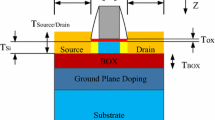Abstract
The change of P+ deep well doping will affect the charge collection of the active and passive devices in nano-technology, thus affecting the propagated single event transient (SET) pulsewidths in circuits. The propagated SET pulsewidths can be quenched by reducing the doping of P+ deep well in the appropriate range. The study shows that the doping of P+ deep well mainly affects the bipolar amplification component of SET current, and that changing the P+ deep well doping has little effect on NMOS but great effect on PMOS.
Similar content being viewed by others
References
Shivakumar P, Kistler M, Keckler S W, et al. Modeling the effect of technology trends on the soft error rate of combinational logic. In: Proc. Int Conf Dependable Syst Networks, Washington, DC, 2002
Uemura T, Tosaka Y, Satoh S. Neutron-induced soft-error simulation technology for logic circuits. Jpn J Appl Phys, 2006, 45(4): 3256–3259
Rodbell K P, Heidel D F, Tang H K, et al. Low-energy protoninduced single-event-upsets in 65 nm node, silicon-on-insulator, latches and memory cells. IEEE Trans Nucl Sci, 2007, 54(6): 2474–2479
Baumann R C, Radaelli D. Determination of geometry and absorption effects and their impact on the accuracy of alpha particle soft error rate extrapolations. IEEE Trans Nucl Sci, 2007, 54(6): 2141–2148
Roche P, Gasiot G. Impacts of front-end and middle-end process modifications on terrestrial soft error rate. IEEE Trans Dev Mater Reliab, 2005, 5(3): 382–396
Narasimham B, Amusan O A, Bhuva B L, et al. Extended SET pulses in sequential circuits leading to increased SE vulnerability. IEEE Trans Nucl Sci, 2008, 55(6): 3077–3081
Qin J R, Chen S M, Liu B W, et al. Research on single event transient pulse quenching effect in 90 nm CMOS technology. Sci China Tech Sci, 2011, 54: 3064–3069
Amusan O A, Sternberg A L, Witulski A F, et al. Single event upsets in a 130 nm hardened latch design due to charge sharing. In: Proc 45th Int Reliab Phys Symp, 2007
Amusan O A, Massengill L W, Baze M P, et al. Directional sensitivity of single event upsets in 90 nm NMOS due to charge sharing. IEEE Trans Nucl Sci, 2007, 54(6): 2584–2589
Dodd P E, Massengill L W. Basic mechanism and modeling of single-event upset in digital microelectronics. IEEE Trans Nucl Sci, 2003, 50(6): 583–602
Hauser J R, Diehl-Nagle S E, Knudson A R, et al. Single event upset and total dose radiation effects on rad-hard SRAMs. IEEE Trans Nucl Sci, 1985, 32(6): 4115–4121
Warren K M, Weller R A, Mendenhall M H. The contribution of nuclear reactions to heavy ion single event upset cross-section measurements in a high-density SEU hardened SRAM. IEEE Trans Nucl Sci, 2005, 52(6): 2125–2131
Hsu S, Fiez T S, Mayaram K. Modeling of substrate noise coupling for NMOS transistors in heavily doped substrates. IEEE Trans Elec Dev, 2005, 52(4): 1880–1886
Saxena P, Bhat N. Process technique for SEU reliability improvement of deep sub-micron SRAM cell. Solid State Elec, 2003, 47(4): 661–664
Ahlbin J R, Massengill L W, Bhuva B L, et al. Single-event transient pulse quenching in advanced CMOS logic circuits. IEEE Trans Nucl Sci, 2009, 54(6): 3050–3056
Atkinson N M. Single-event characterization of a 90-nm bulk cmos digital cell library. Thesis of Master Degree. Tennessee: Dept Elect Eng, Vanderbilt University, 2010
Turowski M, Raman A, Jablonski G. Mixed-mode simulation and analysis of digital single event transients in fast CMOS ICs. 14th International Conference on Mixed Design of Integrated Circuits and Systems, 2007
Olson B D, Amusan O A, Dasgupta S, et al. Analysis of parasitic PNP bipolar transistor mitigation using well contacts in 130 nm and 90 nm CMOS technology. IEEE Trans Nucl Sci, 2007, 54(4): 894–897
Amusan O A, Massengill L W, Baze M P, et al. Mitigation techniques for single-event-induced charge sharing in a 90-nm bulk CMOS process. IEEE Trans Dev Mater Rel, 2009, 9(2): 311–317
Author information
Authors and Affiliations
Corresponding author
Rights and permissions
About this article
Cite this article
Qin, J., Chen, S., Liu, B. et al. The effect of P+ deep well doping on SET pulse propagation. Sci. China Technol. Sci. 55, 665–672 (2012). https://doi.org/10.1007/s11431-011-4644-1
Received:
Accepted:
Published:
Issue Date:
DOI: https://doi.org/10.1007/s11431-011-4644-1



